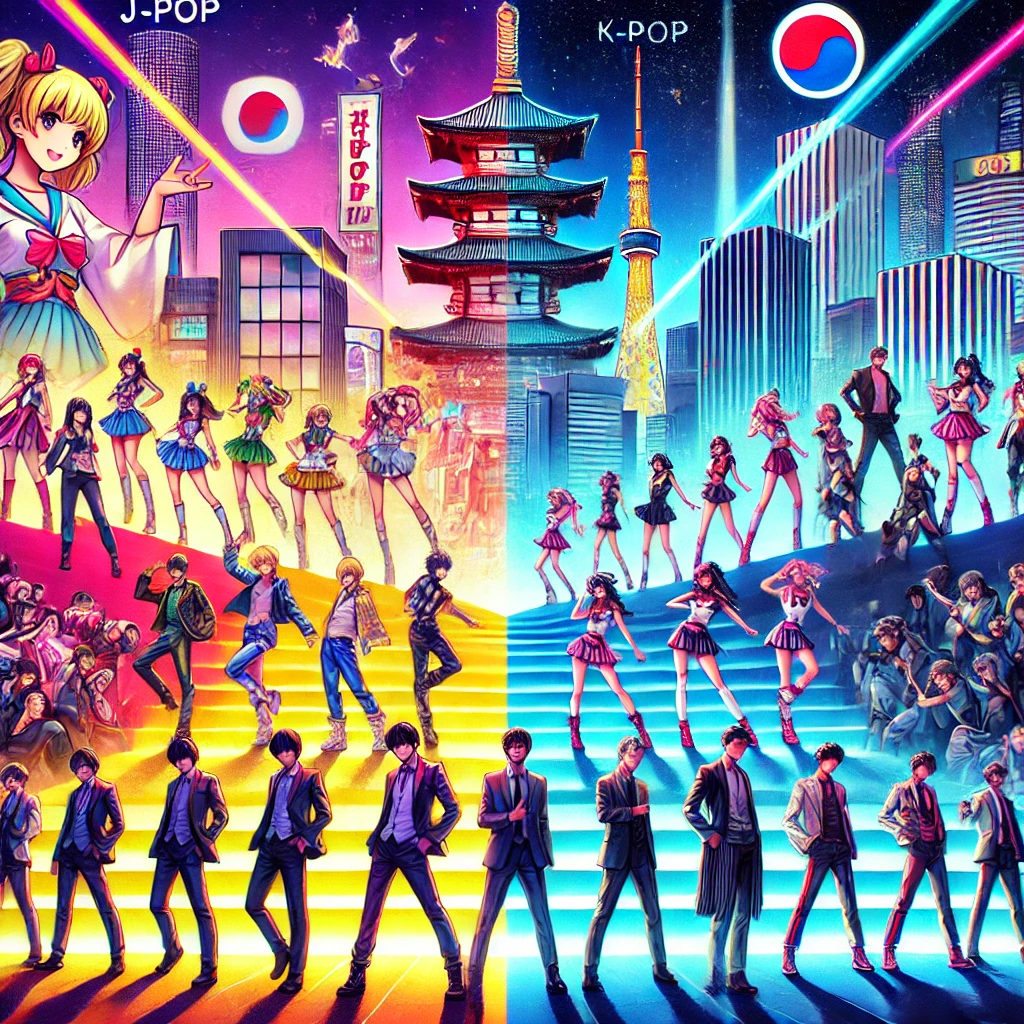Table of Contents
Introduction to J-Pop and K-Pop
J-Pop, short for Japanese pop music, emerged in the late 20th century, laying its foundation in the 1960s with influences from Western pop, rock, and electronic music. This genre gained popularity during the 1980s and 1990s, characterized by its vibrant melodies, diverse styles, and visually striking music videos. J-Pop often integrates elements of traditional Japanese music and culture, creating a unique sound that resonates with local audiences. Notable artists such as Hikaru Utada and Arashi transformed J-Pop into a cultural phenomenon, establishing the genre as not only a musical form but as a significant part of Japanese identity and soft power on the global stage.
Conversely, K-Pop or Korean pop music began to form in South Korea during the early 1990s, drawing inspiration from American and European music trends. Initially overshadowed by other musical genres, K-Pop quickly evolved, especially with the advent of the internet and social media in the 2000s. The genre is marked by its polished production, catchy hooks, choreographed performances, and fandom culture, which has played a crucial role in its international appeal. Groups like BTS and BLACKPINK have not only achieved commercial success domestically but have also impacted global music charts, demonstrating K-Pop’s expansive reach and influence.
Both genres serve as cultural ambassadors for their countries, showcasing elements of traditional and contemporary societal values. Their evolution over the years reflects broader changes within Japanese and Korean societies, and they highlight unique storytelling techniques that engage audiences at home and worldwide. The rise of both J-Pop and K-Pop has sparked significant interest in East Asian cultures, setting the stage for a comparative analysis of their respective music scenes and global impact.

The Evolution of J-Pop
J-Pop, or Japanese pop music, has undergone a significant transformation since its inception in the 1960s. This genre, characterized by its vibrant melodies and distinct cultural influences, has roots that intertwine with various music styles, both traditional and contemporary. The beginnings of J-Pop can be traced back to the early rock and roll movements brought to Japan by American servicemen after World War II. Artists like Kyu Sakamoto, famous for his iconic hit “Sukiyaki” in 1961, played a pivotal role in introducing Western musical elements into Japanese music, which laid the groundwork for what would become J-Pop.
Throughout the 1970s and 1980s, J-Pop continued to evolve, incorporating aspects of disco, electronic music, and the melodrama often associated with Japanese culture. The term “J-Pop” itself emerged in the 1990s, when idols like Namie Amuro and Hikaru Utada revolutionized the scene with their fresh sounds and complex choreography. Namie Amuro’s debut in 1992 set a cultural precedent, blending traditional Japanese themes with modern pop, which resonated with a younger audience. Utada, whose album “First Love” remains one of the best-selling albums in Japan, showcased how J-Pop could cross borders, gaining recognition in international markets.
Distinct stylistic elements of J-Pop include its lyrical focus on themes of love, nostalgia, and personal reflection, often presented in emotive and sometimes theatrical fashion. Unlike K-Pop, which is heavily influenced by diverse global trends and often emphasizes elaborate performance and choreography, J-Pop has maintained a closer connection to its cultural roots. In contrast to K-Pop’s polished aesthetics and strategic marketing, J-Pop often embraces a more organic evolution, prioritizing musicality alongside visual presentation. Therefore, while both genres share global appeal, their unique characteristics, historical progression, and cultural roots differentiate them within the broader landscape of music.
The Rise of K-Pop: A Cultural Phenomenon
K-Pop, short for Korean pop music, emerged as a significant cultural force in the late 20th century, particularly gaining momentum in the 1990s. The genre’s roots can be traced back to various influences, including Western pop, hip-hop, and electronic music. However, it was the establishment of influential entertainment companies such as SM Entertainment, YG Entertainment, and JYP Entertainment that played a pivotal role in shaping K-Pop into what it is today. These companies are renowned for their rigorous training programs for aspiring idols, often requiring years of preparation in singing, dancing, and performing before debuting in the competitive music environment.
One of the hallmark characteristics of K-Pop is its meticulous production of music videos and choreographed performances. K-Pop artists are trained to combine song, dance, and visual aesthetics in a way that captivates audiences. The high production values, vibrant visuals, and innovative choreography associated with K-Pop set it apart from other music genres, including J-Pop. Each release is often accompanied by a visually stunning music video that not only showcases the group’s talent but also tells a compelling story, further enhancing the emotional connection with viewers.
The genre’s approach has led to a distinctive style that regularly incorporates diverse musical elements, from rap verses to classical instrumentation, creating a sound that appeals to a wide international audience. As K-Pop began to gain traction on global platforms, it transcended geographical boundaries, attracting a diverse fanbase worldwide. This phenomenon showcases a significant cultural impact, contributing to the growing interest in South Korean culture, language, and trends. K-Pop’s combination of aesthetics, training, and strategic marketing has not only paved the way for international success but has also positioned it as a defining aspect of contemporary music culture.
Key Differences in Sound and Style
When analyzing the musical landscapes of J-Pop and K-Pop, it is essential to recognize the distinct sound and style characteristics inherent in each genre. J-Pop, or Japanese pop music, often reflects a fusion of various musical influences, including rock, electronic, and traditional Japanese melodies. This eclecticism contributes to a diverse sound palette, often showcasing strong melodic lines and layered harmonies that are a hallmark of the genre. Vocal techniques in J-Pop can vary significantly, with singers often emphasizing emotive expression and a wide range of vocal styles.
In contrast, K-Pop, or Korean pop music, is known for its polished production and dynamic song structures. It typically includes an array of genres, such as hip-hop, R&B, and EDM, often merged seamlessly within a single track. K-Pop is characterized by its catchy hooks and rhythmic shifts, engaging listeners through diverse musical elements. Vocal performances in K-Pop frequently incorporate strong technique, powerful high notes, and occasionally a focus on rap segments, which adds another layer of complexity to the musical experience.
Instrumentation also varies between the two genres. J-Pop frequently integrates live instruments, providing an organic feel that resonates with listeners. Conversely, K-Pop heavily relies on synthesized sounds and electronic beats, contributing to a contemporary and futuristic aesthetic. This distinction in instrumentation affects the overall production style and listening experience.
The themes explored in J-Pop often touch on personal emotions, nostalgic reflections, and cultural elements, creating a deeper connection with the audience. In contrast, K-Pop’s lyrics frequently focus on themes of ambition, youth, and social issues, often delivered in a more direct manner. These differences in musical themes and overall messaging highlight what makes each genre unique, showcasing the rich diversity of contemporary Asian pop music.
Visuals and Fashion: The Role of Aesthetics
Visual aesthetics play a pivotal role in the overall appeal and success of both J-Pop and K-Pop, influencing not only the music but also the culture surrounding it. Each genre approaches visuals with its unique flair, reflecting the distinct cultural heritage of Japan and South Korea. In J-Pop, visual elements often highlight fantastical themes with an emphasis on vibrant colors, exaggerated styles, and artistic concepts. Iconic figures like Kyary Pamyu Pamyu have redefined pop aesthetics, bringing vivid storytelling to their music videos through eclectic fashion choices and bold imagery.
On the other hand, K-Pop emphasizes a polished and sophisticated aesthetic, characterized by high-end fashion and choreographed performances that present an idealized image. Groups such as BTS and BLACKPINK use striking visuals to enhance their storytelling, with elaborate costumes and makeup that resonate with global audiences. The music videos often feature intricate choreography that increases the engagement of viewers, further solidifying the connection between the visual presentation and the auditory experience of the music.
The influence of both J-Pop and K-Pop extends beyond their home countries, shaping global fashion trends and inspiring regional fashion industries. For instance, K-Pop idols frequently collaborate with luxury brands and designers, setting trends that lead to a surge in demand for specific clothing styles. Meanwhile, J-Pop artists often draw from traditional elements and juxtapose them with modern fashion, creating a unique blend that captivates diverse audiences. Marketing strategies within these industries are closely tied to aesthetically appealing visuals, ensuring that imagery and branding complement the musical content. This synergy plays a critical role in cultivating the fan experience, making visuals a crucial part of both J-Pop and K-Pop’s global footprint.
Fandom Culture: Engagement and Community
Fandom culture plays a pivotal role in the engagement and support of both J-Pop and K-Pop artists, fostering vibrant communities that significantly influence the longevity and success of each genre. J-Pop fans, often referred to as “wota,” engage deeply with their favorite artists through a variety of means. These fans typically participate in live concerts, known as “idol events,” where audience interaction is encouraged, creating an energetic atmosphere. Merchandise sales, including light sticks, photo cards, and apparel, serve as tangible symbols of loyalty, allowing fans to display their dedication visually. Social media platforms, particularly Twitter and Instagram, provide essential spaces for fans to discuss their shared interests, share fan art, and coordinate community events.
Conversely, K-Pop fandoms, known as “stans,” exhibit similarly enthusiastic behavior but with distinct characteristics. The phenomenon of “fandom culture” in K-Pop is often exemplified by highly organized fan clubs, which engage fans worldwide. These clubs facilitate large-scale projects, such as charity initiatives and streaming campaigns aimed at chart success. The prominent use of social media platforms, particularly TikTok and YouTube, amplifies fan interaction not only with artists but also among the fanbase itself, fostering global connections. K-Pop fans actively participate in fandom challenges, trends, and voting polls for various music awards, showcasing their support through coordinated efforts.
The sense of community within these fandoms enhances the overall experience, as fans come together to express their passion and support for their idols. Events such as fan meetings and concerts serve to deepen these connections, while exclusive merchandise reinforces the intimate bond between artists and their supporters. Ultimately, the emotional investment and community-building characteristics of both J-Pop and K-Pop fandoms significantly contribute to the enduring popularity and cultural prevalence of their respective genres.
International Influence and Global Reach
J-Pop and K-Pop have significantly impacted the global music landscape, creating unique pathways for cultural exchange and artistic collaboration. Initially, J-Pop, which emerged in the 1990s, successfully established a foothold in the Asian market. Iconic artists like Hikaru Utada and Ayumi Hamasaki garnered tremendous success not only in Japan but also in neighboring countries, such as South Korea and Taiwan. Their melodic style, engaging performances, and catchy tunes resonate with diverse audiences. However, it is K-Pop that has captured international attention more dramatically in recent years, shattering geographic barriers and achieving unprecedented chart success in Western markets.
Groups such as BTS and BLACKPINK serve as prime examples of K-Pop’s global reach. BTS, in particular, has made history by topping the Billboard Hot 100, a feat that highlighted the massive crossover potential of K-Pop music. Their collaborations with Western artists, including Halsey and Ed Sheeran, underscore the genre’s ability to blend different musical styles and appeal to a broader audience. Similarly, BLACKPINK has collaborated with international artists like Lady Gaga and Selena Gomez, further solidifying its place on the global stage.
Social media platforms also play a crucial role in amplifying the reach of both J-Pop and K-Pop. Through platforms such as YouTube, Twitter, and Instagram, fans around the globe can easily access and share their favorite artists’ content, thus driving the popularity of these genres. The systematic engagement with fans, dubbed the “fandom culture,” creates a community that supports their favorite acts, reinforcing their influence. Overall, the international success of J-Pop and K-Pop illustrates not only their unique musicality but also their potential to transcend cultural boundaries and create a shared sonic experience worldwide.
Collaborations and Crossovers: Blurring Boundaries
The interaction between J-Pop and K-Pop has paved the way for a plethora of collaborations that blend the distinct sounds of these two influential genres. Notable projects have emerged, showcasing how artists from Japan and South Korea can unite to create innovative music that appeals to a wider audience. For example, the collaboration between the J-Pop group Arashi and the K-Pop band BTS marked a significant moment, as both fanbases were eager to see the fusion of their favorite artists. Such partnerships not only highlight the individual strengths of each genre but also expand the musical landscape, allowing for diverse auditory experiences.
These crossovers often embody the blending of cultures, where traditional J-Pop melodies meet contemporary K-Pop beats, resulting in tracks that resonate with fans internationally. The collaborative work embodies a spirit of experimentation, showcasing how artists can step beyond their cultural boundaries to create something truly unique. This melding of styles can be credited for its ability to dissolve preconceived notions and invite new listeners to explore both music scenes. Each collaboration tends to generate significant buzz in social media platforms, traditionally bridging gaps between the two genres and fostering community engagement among diverse fanbases.
The reception of these collaborations varies between Japan and Korea, reflecting each country’s unique cultural perspectives. K-Pop fans may embrace the distinctive charm of J-Pop collaborations due to the genre’s vibrant performance styles and storytelling elements. Conversely, J-Pop audiences often appreciate the polished production and global market appeal characteristic of K-Pop. As these crossover projects continue to thrive, they not only enhance the music industry but also play a role in promoting an increasingly globalized music scene, encouraging ongoing dialogue between the two cultures. Ultimately, collaborations between J-Pop and K-Pop artists exemplify the exciting potential of creative synergy in music.
Conclusion: The Future of J-Pop and K-Pop
As we reflect on the ever-evolving landscapes of J-Pop and K-Pop, it becomes evident that both genres possess distinct characteristics that contribute to their unique identities. J-Pop, with its roots deeply embedded in Japanese culture, showcases an extensive range of musical styles and often emphasizes individuality and artistic expression. Conversely, K-Pop has garnered widespread recognition for its highly polished productions, strategic marketing, and the incorporation of diverse musical influences, resulting in an expansive global reach.
The analysis highlights how the competitive dynamics between J-Pop and K-Pop have transformed over the years, particularly in light of the latter’s ascendance in the international music scene. While K-Pop has been successful in leveraging social media platforms and global fandoms to expand its audience, J-Pop maintains a loyal fan base that appreciates its cultural authenticity and emotional storytelling. These differences in strategy also underscore how each genre appeals to varying cultural sensibilities and market demands.

Looking forward, it is likely that globalization will continue to influence both J-Pop and K-Pop, leading to potential collaborations and cross-pollination between artists from these two vibrant industries. The rise of digital platforms presents an opportunity for greater exposure and engagement, allowing fans to collect and share experiences that transcend geographical boundaries. As the music scene evolves, we may witness further diversification within these genres, encouraging artists to experiment with sounds and styles from different cultures.
In this fluid and interconnected environment, fans and enthusiasts are invited to reflect on their own interactions with these genres. Whether through attending concerts, engaging with online communities, or exploring the rich narratives that J-Pop and K-Pop offer, understanding personal preferences and experiences can enrich one’s appreciation for the broader Asian pop music landscape. Ultimately, the future holds exciting possibilities for both J-Pop and K-Pop as they continue to adapt to and influence the global music culture.





